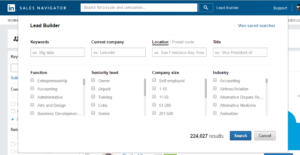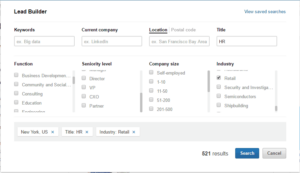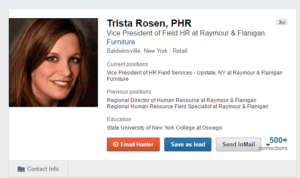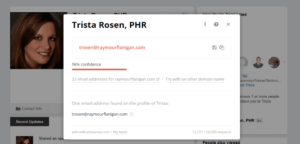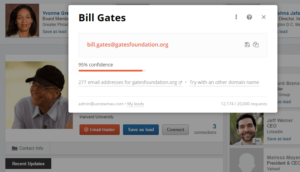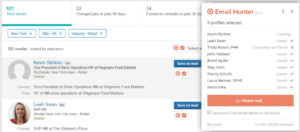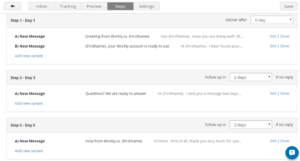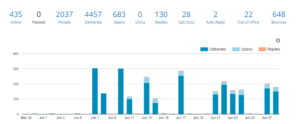I often hear frustration from colleagues that there are no automated instruments for outbound sales in the B2B sector.
When it comes to marketing, people usually begin with making cold calls and sending spam emails. You might look into trying to build up your inbound marketing channels, but this depends on people knowing about your services and contacting you about them. There’s no denying that outbound techniques are still one of the most effective ways of garnering new business. Here, I describe (or perhaps, advertise) three services that have helped us easily enter new markets with minimal expenses.
How Everything Began.
After reading literature on cold calls, I came to realize that sales through email marketing would be the most effective and least expensive method for our Workly project.
Workly is a SaaS product for employee time tracking in small and medium businesses (up to 200 employees). Our target audience comprises such sectors as HoReCA, retail, and other services.
First, we needed to do a few things…
- Find a large number of clients, constituting our target audience,
- Find their email addresses, and
- Launch a personalized email campaign.
Stage 1: LinkedIn and Getting to Know Sales Navigator.
LinkedIn is an extremely popular networking platform in the US and Europe, used for blogging, recruitment and sales. Generally, all companies seek potential employees here and because of this, users’ personal profiles are filled out in their entirety. Using the search function one can easily find the right sort of person, establish a friendship with them, write them a message, look through their contacts and so on. The trouble is, this process is not automated. In other words, you have to search for people within different sectors, one by one, and enter their data into your table.
One fine day, LinkedIn offered Sales Navigator to me, free of charge, for the duration of one month.
Sales Navigator is an incredible tool, which can filter all your inquiries, including:
-
- 1. Industry of a company
- 2. Status of a lead in a company (founder, owner, director,…, trainee)
- 3. Position of a lead
- 4. Employee number (which is of utmost importance for our project)
- 5. Region of a company
Using these criteria one can easily collect all New York-based HR specialists from the retail sector. In all, this method gave us 521 results that could turn into potential leads.
LinkedIn turned out to be a cost-effective supplier of leads for email campaigns. The cost of Sales Navigator amounts to $70 per month. This is substantially cheaper and much more effective than an employee, who would have to find leads manually.
Stage 2: Email Hunting
After the list of my target audience was formed, I needed to find all email addresses of these leads. How could it be done? Writing to everyone through LinkedIn – too complicated. Searching in Google – even more difficult.
After several hours of searching, I came across a service called Email Hunter. The strength of the service consists in that it can find email addresses on any web page. The extension is added to Chrome – and everything works seamlessly. One of the most exciting features is that Email Hunter is extremely well integrated with LinkedIn and available right in the profile of a lead.
Clicking on the button leads to immediate results:
Voila! This unsophisticated operation lets us transfer a client’s email address to our mailing list.
Email Hunter doesn’t always provide correct emails. As far as I understand, it automatically identifies the type of email address in domain name and generates an email of a selected person. For instance, Bill Gates Foundation has the following type of email address: {name}.{surname}@gatesfoundation.org
Here is the email of Bill itself:
Now, try finding email of Zuckerberg ☺.
Stage 3: Mass Hunting Method.
Not so long ago, Email Hunter issued beta release, a service that allows the extraction of emails right from the search page. Each page contains 10 contacts, whose email addresses can be hunted and saved in the list of leads with just one click after that, the list can be exported in CSV format and used for sales outreach campaign. This simplifies the process even more.
The service is fine, but it’s worth noting that email addresses are not always correct or existent. The cost of service equals $200 for 20,000 requests (I purchased exactly this volume).
Stage 4: The selection of service for running email campaigns.
Once you’ve collected a huge selection of emails, you don’t want to become notorious as a spammer by sending emails through a personal email account. For this, there are special services that have been created especially for sending out sales outreach campaigns. While there are many Mailchimp alternatives out there, the most popular is MailChimp.
Even though automation was an option, we wanted to send personalized messages to our leads in the same way we would write to colleagues and friends. MailChimp sends all emails through its own servers with all letters arriving in Promo folder in Gmail. In other words, it becomes more than obvious to the receiver that the email is part of a marketing campaign.
In the end, we chose a service called ReplyApp to address this issue. Let me say in advance, that technical support of this resource is superior! Their responsiveness to requests is astonishing, and they guide you through every stage of setting up an email campaign. In your email client settings, you need to indicate SMTP and POP data of your email server. This allows you to reply to and send emails as if they were sent from your address directly to recipient’s inbox.
The features offered by ReplyApp addressed all of our needs, including:
– Sending personalized emails, addressing all recipients by name,
– Planning and sending out several stages of emails,
– Sending successive email messages only if a recipient has not answered our previous message,
– Tracking the results of an email campaign,
– Receiving replies in both ReplyApp and our own emai accounts, and finally
– Connecting an entire team to the system with own accounts.
This service is incredibly convenient, and costs 70$ per employee per month.
Finally, Our Results
Today, 8 sales managers work with markets in South America, USA, South Africa, Australia, East Asia and CIS. Using this potent combination of SaaS products, they close at least 10 deals per month – each.
More than 20,000 emails have been researched, collected and sent, and we’ve closed about 180 deals with new clients. Roughly 1,000 of these leads were found while we were still using these services on a free trial basis.
While our click-through-rate remains low, we work on refining the tone of our pitch in emails. The main thing here is that overall, this process requires neither much dedication nor intellectual refinement. We paid back all expenditure incurred on the launch of email marketing with interest and now have a stable outbound channel for the attraction of interested leads.
Hope this article has given you a good introduction to the services available to make your outbound email campaigns more aggressive and effective.
by Iskandar Ganiboev, VP of Sales & Marketing @ Workly.io
![How To Build An Effective Sales Outreach Campaign [Guest Post] How To Build An Effective Sales Outreach Campaign [Guest Post]](https://reply.io/wp-content/uploads/Pasted-image-at-2016_07_27-04_46-PM.png)

